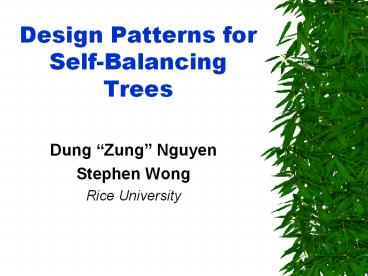Design Patterns for Self-Balancing Trees PowerPoint PPT Presentation
Title: Design Patterns for Self-Balancing Trees
1
Design Patterns for Self-Balancing Trees
- Dung Zung Nguyen
- Stephen Wong
- Rice University
2
Resources
http//www.owlnet.rice.edu/swong/TeachJava
(http//www.owlnet.rice.edu/swong/TeachJava/NTre
e/presentation/NTree.ppt)
http//www.exciton.cs.rice.edu/research/OOPSLA02
3
Motivations
Consider 2-3-4 Trees.
- Classic self-balancing tree structure
- Generalizable to B-trees.
- Difficult and complex. Who shows real code?
- Whats the proper abstraction?
- Should be able to extend prior work on decoupling
algorithms from data structures.
4
A 2-3-4 Tree is
- Empty
or
- Non-Empty, in 3 possible states
- 2-State 1 data element 2 sub-trees.
- 3-State 2 data elements 3 sub-trees.
- 4-State 3 data elements 4 sub-trees.
5
Variant vs. Invariant Operations
- Self-balancing insertion is not an intrinsic
(invariant) operation of a tree. - What are the invariant operations?
- Gettors Constructors.
- Constructive and Destructive operations
- Constructive Splice a tree into another.
- Destructive Split a tree into a 2-state.
6
Splittin and Splicin
Split Up
Splice
B
Intrinsic operations on the tree STRUCTURE, not
the data!
7
Structural Operations
8
Con/De-struction
9
Visitor Design Pattern
AHost execute(v)
AVisitor case1() case2() case3()
Invariant Hosti calls casei of the visitor.
Fixed of methods ? fixed of hosts
Non-Extensible!
10
Generalized Visitors
AHost execute(v)
AVisitor caseAt(int i)
Invariant Hosti calls caseAt(i) of the visitor.
Unbounded of hosts!
11
TreeN and Algorithms
12
toString() Algorithm
public class ToStringAlgo implements ITreeNAlgo
// Constructors omitted public Object
caseAt(int idx, TreeN host, Object key)
switch(idx) case 0 return "
" default
String sData "", sTrees""
for(int i 0iltidxi) sData
host.getDat(i)" " sTrees
host.getChild(i).execute(toStringHelp,"
")"\n"
sTrees host.getChild(idx).execute(toStringHelp,
" ").toString() return sData
"\n"sTrees
ITreeNAlgo toStringHelp see next slide.
Empty Tree
Non-Empty Tree
Prefix data
13
ToString() Helper
private final static ITreeNAlgo toStringHelp
new ITreeNAlgo() public Object caseAt(int
idx, TreeN host, Object prefix)
switch(idx) case 0 return "_
" default
String sData "", sTrees""
for(int i 0iltidxi)
sData host.getDat(i)" "
sTrees prefix
(String) host.getChild(i).execute(this,
prefix" ")"\n"
sTrees prefix
host.getChild(idx).execute(this,
prefix" " ).toString()
return "_ "sData "\n"sTrees
Empty Tree
Non-Empty Tree
Prefix data
14
Vertical Data Transport
No net height change except at root and leaves!
15
Command Design Pattern
Invoker
Performs a task.
ICommand Object apply(Object inp)
No specified semantic!
Commands Lambda Functions
Anonymous inner classes provide closures for
lambdas!
16
Insertion Heuristics
- Insertion must take place at the leaf.
- Tree must grow only at the root.
Must transport data from the leaves to the
root without affecting the height balance.
17
Insertion Algorithm
- Find insertion point at the leaf and splice new
data in. - Use Split-and-Apply visitor to transport excess
data upwards. - Visitor passed as parameter to recursive call.
- Non-root split-and-splice
- Root node split-and-no-op will cause entire tree
to grow in height. - Abstract the splice/no-op as a command passed to
the visitor!
Lambdas simplify code!
18
Deletion Heuristics
- Deletion only well-defined at leaf.
- Data might exist anywhere in the tree.
- Tree can only shorten at root.
? Push candidate data down from the root to the
leaves.
? Bubble excess data back to the root.
Must transport data from the root to the leaves
and from the leaves to the root without affecting
the height balance.
19
Deletion Algorithm
- Identify candidate data
- split down at candidate and collapse with
children. - If root is a 2-node, then tree will shorten.
- Data to delete will appear as 2-node below
leaves. - Use Split-and-Apply to transport excess data
upwards.
No Rotations!
20
Conclusions
- Proper abstraction leads to
- Decoupling
- Simplicity
- Flexibility extensibility
- Generalized Visitors open up new possibilities.
- Self-balancing trees teach
- Abstract decomposition
- Design patterns
- Component-frameworks
- Lambda calculus
- Proof-of-correctness complexity analysis

